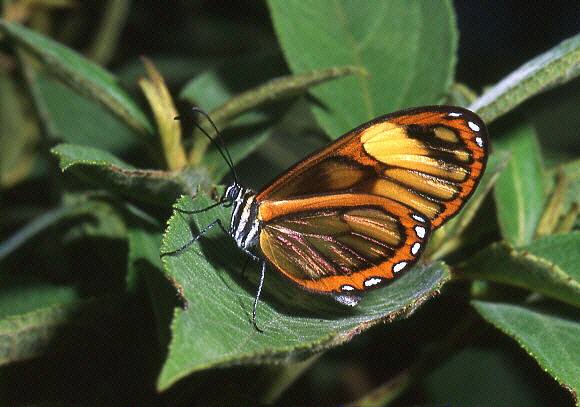
Introduction
The Ithomiini comprises of 376 known species, although it is likely that at least another 30 will be discovered in the near future. All are confined to the neotropical region. Ithomiines are unpalatable to birds, and are consequently mimicked in appearance by many other species. These include other unpalatable species (Müllerian mimics), not only from the Ithomiinae but also from several other butterfly families. There are also a large number of edible species (Batesian mimics) which have evolved similar patterns. Birds have the ability to memorise butterfly patterns and so learn to avoid eating noxious species, but are also fooled into ignoring similarly marked edible species.
Ithomiines are characterised by having small eyes, slender abdomens and long drooping antennae that lack distinct clubs. Males have a plume of long androconial scales or “hair pencils” on the costa of their hindwings. These are hidden from view when the butterflies are at rest, but are displayed when the wings are held open during courtship. Other Ithomiine characteristics include a very slow and deep wing beat, and a preference for inhabiting the darkest recesses of the forest understorey.
The genus Pteronymia contains 46 species, distributed variously from Mexico to Bolivia. They are a diverse group with much variation in pattern and markings between species, but can be recognised by the distinctive hindwing venation.
Pteronymia veia is found in Colombia, Ecuador, Venezuela and Guyana.
Habitats
This species inhabits cloudforest habitats at altitudes between about 1400-2000m.
Lifecycle
To be completed.
Adult behaviour
Like other Ithomiines, the butterflies spend long periods at rest on the foliage of small shrubs in the darkness of their rainforest and cloudforest habitats. They are extremely nervous, and if disturbed fly immediately, only to resettle on another nearby leaf. The flight is very slow, with characteristic deep wing beats. When feeding in the open they behave very differently – both sexes being very placid and reluctant to leave their flowers.
The males of most Pteronymia species pollinate Epidendrum orchids.
Males sequester pyrrolizidine alkaloids from Heliotropium, Tournefourtia, Myosotis (Boraginaceae), Eupatorium, Neomiranda and Senecio (Asteraceae). These chemicals confer toxic qualities to the butterflies which deter bird attacks.
The chemicals are also used in the production of pheromones. Often the males of several Ithomiine species will gather together at communal leks, where they release these pheromones from hair-like androconial scales on the leading edge of their upperside hindwings. These attract more males, which in turn release further pheromones.
After a few days the lek may include 50 or more adults comprised of as many as dozen different species. Passing females are attracted to the leks by the complex fragrances. Their presence stimulates the males to open their wings and release further pheromones that entice them into copulation. Females obtain sustenance from nectar, and also visit bird droppings which provide them with a source of nitrogen that assists with the development of their eggs.
